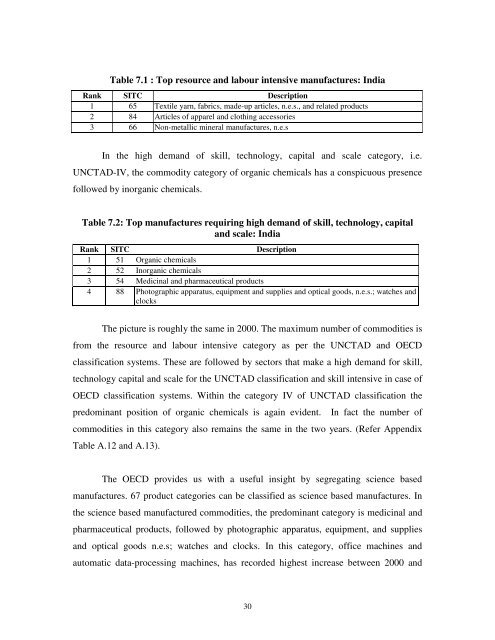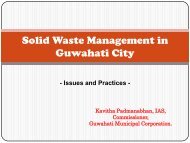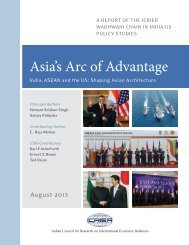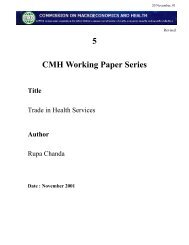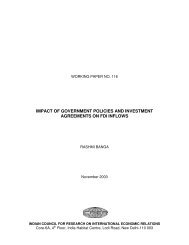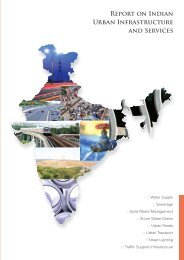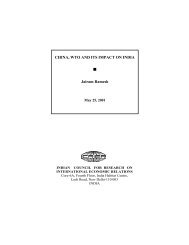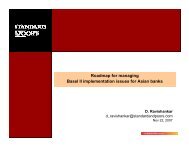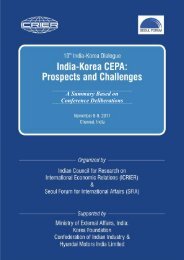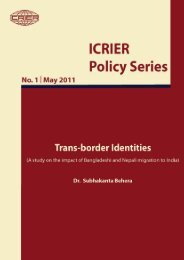an analysis for india and china - icrier
an analysis for india and china - icrier
an analysis for india and china - icrier
You also want an ePaper? Increase the reach of your titles
YUMPU automatically turns print PDFs into web optimized ePapers that Google loves.
Table 7.1 : Top resource <strong>an</strong>d labour intensive m<strong>an</strong>ufactures: India<br />
R<strong>an</strong>k SITC Description<br />
1 65 Textile yarn, fabrics, made-up articles, n.e.s., <strong>an</strong>d related products<br />
2 84 Articles of apparel <strong>an</strong>d clothing accessories<br />
3 66 Non-metallic mineral m<strong>an</strong>ufactures, n.e.s<br />
In the high dem<strong>an</strong>d of skill, technology, capital <strong>an</strong>d scale category, i.e.<br />
UNCTAD-IV, the commodity category of org<strong>an</strong>ic chemicals has a conspicuous presence<br />
followed by inorg<strong>an</strong>ic chemicals.<br />
Table 7.2: Top m<strong>an</strong>ufactures requiring high dem<strong>an</strong>d of skill, technology, capital<br />
<strong>an</strong>d scale: India<br />
R<strong>an</strong>k SITC Description<br />
1 51 Org<strong>an</strong>ic chemicals<br />
2 52 Inorg<strong>an</strong>ic chemicals<br />
3 54 Medicinal <strong>an</strong>d pharmaceutical products<br />
4 88 Photographic apparatus, equipment <strong>an</strong>d supplies <strong>an</strong>d optical goods, n.e.s.; watches <strong>an</strong>d<br />
clocks<br />
The picture is roughly the same in 2000. The maximum number of commodities is<br />
from the resource <strong>an</strong>d labour intensive category as per the UNCTAD <strong>an</strong>d OECD<br />
classification systems. These are followed by sectors that make a high dem<strong>an</strong>d <strong>for</strong> skill,<br />
technology capital <strong>an</strong>d scale <strong>for</strong> the UNCTAD classification <strong>an</strong>d skill intensive in case of<br />
OECD classification systems. Within the category IV of UNCTAD classification the<br />
predomin<strong>an</strong>t position of org<strong>an</strong>ic chemicals is again evident. In fact the number of<br />
commodities in this category also remains the same in the two years. (Refer Appendix<br />
Table A.12 <strong>an</strong>d A.13).<br />
The OECD provides us with a useful insight by segregating science based<br />
m<strong>an</strong>ufactures. 67 product categories c<strong>an</strong> be classified as science based m<strong>an</strong>ufactures. In<br />
the science based m<strong>an</strong>ufactured commodities, the predomin<strong>an</strong>t category is medicinal <strong>an</strong>d<br />
pharmaceutical products, followed by photographic apparatus, equipment, <strong>an</strong>d supplies<br />
<strong>an</strong>d optical goods n.e.s; watches <strong>an</strong>d clocks. In this category, office machines <strong>an</strong>d<br />
automatic data-processing machines, has recorded highest increase between 2000 <strong>an</strong>d<br />
30


